Deciphering the shared mechanisms of Gegen Qinlian Decoction in treating type 2 diabetes and ulcerative colitis via bioinformatics and machine learning
- PMID: 38962743
- PMCID: PMC11220276
- DOI: 10.3389/fmed.2024.1406149
Deciphering the shared mechanisms of Gegen Qinlian Decoction in treating type 2 diabetes and ulcerative colitis via bioinformatics and machine learning
Abstract
Background: Although previous clinical studies and animal experiments have demonstrated the efficacy of Gegen Qinlian Decoction (GQD) in treating Type 2 Diabetes Mellitus (T2DM) and Ulcerative Colitis (UC), the underlying mechanisms of its therapeutic effects remain elusive.
Purpose: This study aims to investigate the shared pathogenic mechanisms between T2DM and UC and elucidate the mechanisms through which GQD modulates these diseases using bioinformatics approaches.
Methods: Data for this study were sourced from the Gene Expression Omnibus (GEO) database. Targets of GQD were identified using PharmMapper and SwissTargetPrediction, while targets associated with T2DM and UC were compiled from the DrugBank, GeneCards, Therapeutic Target Database (TTD), DisGeNET databases, and differentially expressed genes (DEGs). Our analysis encompassed six approaches: weighted gene co-expression network analysis (WGCNA), immune infiltration analysis, single-cell sequencing analysis, machine learning, DEG analysis, and network pharmacology.
Results: Through GO and KEGG analysis of weighted gene co-expression network analysis (WGCNA) modular genes and DEGs intersection, we found that the co-morbidity between T2DM and UC is primarily associated with immune-inflammatory pathways, including IL-17, TNF, chemokine, and toll-like receptor signaling pathways. Immune infiltration analysis supported these findings. Three distinct machine learning studies identified IGFBP3 as a biomarker for GQD in treating T2DM, while BACE2, EPHB4, and EPHA2 emerged as biomarkers for GQD in UC treatment. Network pharmacology revealed that GQD treatment for T2DM and UC mainly targets immune-inflammatory pathways like Toll-like receptor, IL-17, TNF, MAPK, and PI3K-Akt signaling pathways.
Conclusion: This study provides insights into the shared pathogenesis of T2DM and UC and clarifies the regulatory mechanisms of GQD on these conditions. It also proposes novel targets and therapeutic strategies for individuals suffering from T2DM and UC.
Keywords: Gegen Qinlian Decoction; bioinformatics; network pharmacology; traditional Chinese medicine; type 2 diabetes; ulcerative colitis.
Copyright © 2024 Hu, Xiong, Li, Li, Wang, Wang, Zhou and Zheng.
Conflict of interest statement
The authors declare that the research was conducted in the absence of any commercial or financial relationships that could be construed as a potential conflict of interest.
Figures
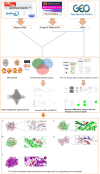
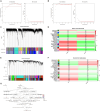
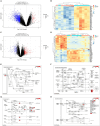

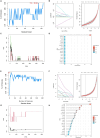


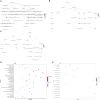
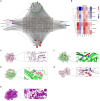

Similar articles
-
In Silico and In Vivo Studies on the Mechanisms of Chinese Medicine Formula (Gegen Qinlian Decoction) in the Treatment of Ulcerative Colitis.Front Pharmacol. 2021 Jun 11;12:665102. doi: 10.3389/fphar.2021.665102. eCollection 2021. Front Pharmacol. 2021. PMID: 34177580 Free PMC article.
-
Network pharmacology and bioinformatics insight into the mechanism of GeGen-QinLian decoction in colorectal cancer and type 2 diabetes mellitus.Medicine (Baltimore). 2025 Jul 18;104(29):e43274. doi: 10.1097/MD.0000000000043274. Medicine (Baltimore). 2025. PMID: 40696679 Free PMC article.
-
[Compatibility mechanism of Gegen Qinlian Decoction in treatment of ulcerative colitis based on network pharmacology].Zhongguo Zhong Yao Za Zhi. 2022 Jul;47(13):3619-3628. doi: 10.19540/j.cnki.cjcmm.20211227.701. Zhongguo Zhong Yao Za Zhi. 2022. PMID: 35850816 Chinese.
-
Efficacy of herbal medicine (Gegen Qinlian Decoction) on ulcerative colitis: A systematic review of randomized controlled trials.Medicine (Baltimore). 2019 Dec;98(52):e18512. doi: 10.1097/MD.0000000000018512. Medicine (Baltimore). 2019. PMID: 31876740 Free PMC article.
-
Constituents, Pharmacokinetics, and Pharmacology of Gegen-Qinlian Decoction.Front Pharmacol. 2021 May 7;12:668418. doi: 10.3389/fphar.2021.668418. eCollection 2021. Front Pharmacol. 2021. PMID: 34025427 Free PMC article. Review.
Cited by
-
Sleep habits, brain functional networks, and type 2 diabetes risk: cohort studies from North American and Asian populations and mediating Mendelian randomization analyses.Diabetol Metab Syndr. 2025 Jun 13;17(1):210. doi: 10.1186/s13098-025-01777-7. Diabetol Metab Syndr. 2025. PMID: 40514702 Free PMC article.
References
-
- Amar J, Chabo C, Waget A, Klopp P, Vachoux C, Bermúdez-Humarán LG, et al. . Intestinal mucosal adherence and translocation of commensal bacteria at the early onset of type 2 diabetes: molecular mechanisms and probiotic treatment. EMBO Mol Med. (2011) 3:559–72. doi: 10.1002/emmm.201100159, PMID: - DOI - PMC - PubMed
LinkOut - more resources
Full Text Sources
Research Materials
Miscellaneous

